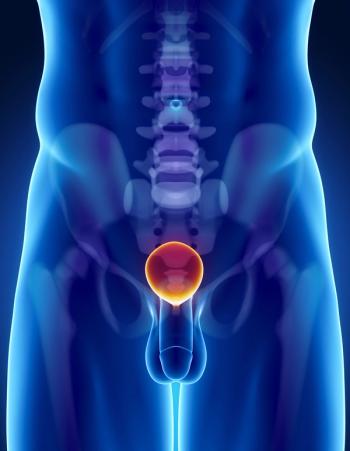
Apalutamide Delays Metastasis in Prostate Cancer
Apalutamide was well-tolerated and associated with delayed metastasis in men with high-risk castration-resistant prostate cancer that has become refractory to conventional hormone therapy, according to an early interim analysis of the phase III SPARTAN clinical trial.
Apalutamide, an investigational nonsteroidal antiandrogen, was well-tolerated and associated with delayed metastasis in men with high-risk castration-resistant prostate cancer (CRPC) that has become refractory to conventional hormone therapy, according to an early interim analysis of SPARTAN, a randomized, placebo-controlled, double-blind phase III clinical trial. The findings were presented (abstract 161) at the 2018 Genitourinary Cancers Symposium, held February 8–10 in San Francisco.
“Apalutamide decreased the risk of metastasis or death by 72% and prolonged median metastasis-free survival by more than 2 years,” reported lead study author Eric J. Small, MD, FASCO, of the University of California, San Francisco.
Apalutamide was generally well-tolerated, with adverse event rates similar to those in the placebo group. A total of 10.7% of patients discontinued apalutamide following adverse events, compared to 6.3% in the placebo group. Baseline quality-of-life scores were well maintained throughout treatment.
The findings suggest that apalutamide should be considered as a possible standard of care for men with high-risk nonmetastatic CRPC, Dr. Small said.
Apalutamide is an investigative next-generation competitive androgen-receptor (AR) inhibitor that prevents androgen binding to the AR, prevents AR translocation to the cell nucleus, and impedes AR-mediated DNA transcription.
A total of 1,207 patients with nonmetastatic CRPC whose prostate-specific antigen levels rose despite continuous androgen deprivation therapy were enrolled in the study and randomly assigned 2:1 to receive apalutamide (240 mg daily; n = 806) or placebo (n = 401).
The median metastasis-free survival time was 40.5 months and 16.2 months in the apalutamide and placebo groups, respectively (hazard ratio, 0.28; 95% CI, 0.23–0.55; P < .001).
“There were low rates of discontinuation due to treatment-related adverse events in both groups,” Dr. Small reported.
It was too soon to calculate overall survival rates but Dr. Small noted a possible early and “encouraging” trend toward a survival benefit for apalutamide.
At a median follow-up of 20.3 months, 61% and 30% of patients in the apalutamide and placebo groups remained on treatment.
“Men with prostate cancer who have no visible evidence of spread but experience a rise in their blood markers can have a poor prognosis and until now, optimal management of their cancer has remained an enigma,” commented American Society of Clinical Oncology expert Sumanta K. Pal, MD, of the City of Hope Comprehensive Cancer Center in Duarte, California. “These findings suggest there may finally be a treatment that holds real promise for extending their health and their lives.”
Newsletter
Stay up to date on recent advances in the multidisciplinary approach to cancer.




















































































